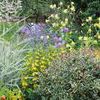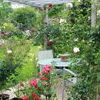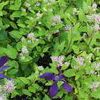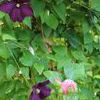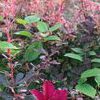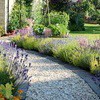We are constantly bombarded by new plants coming on to the market and it is very easy to fall into the trap of buying a plant without thinking of how it would work in relation to all your other plants. Personally I can always squeeze another plant in (!), but inevitably I have to rethink things in the dormant period because plants outgrow their space or don't sit comfortably alongside a plant from another genus. Remember, right plant, right place. If you stick to this rule you can't go far wrong. Of course, sometimes it is trial and error because you need to know how a plant performs in your soil type.
During late Winter and early Spring you have the chance to put things right and think about how your plants could work more cohesively in the border. Which brings me to the issue of height, colour and texture. By colour, I don't mean that you should select every colour under the sun, but try to introduce some harmony by creating a symbiosis between plants. Don't try to combine lots of different plants in one area as this can look bitty. Always plant in groups so that you create impact. Plant verticals such as Delphiniums, Echinacea, Leucanthemum, Digitalis, Campanula lactiflora, Phlox, Grasses, Iris, Verbena bonariensis, Crocosmia etc next to plants that spread and form mounds. This allows the eye to move around the plants and helps distinguish one from the other.
Use flowering climbers to add interest to evergreen shrubs. Clematis are perfect for adding colour throughout the summer and with the right choice of shrub to wind its way through, it can look stunning.
Introduce half standards or shrubs that you can prune to the desired shape to give structure and height to the border and form the essential skeleton to the rest of the planting. Evergreen standards/shrubs will continue to give interest in the winter particularly when covered in a layer of frost and of course, the berries from shrubs like holly will provide essential food to visiting birds.
Another way of adding height is to grow climbing annuals or perennials up a homemade hazel wigwam structure. Hazel is easily available and looks more natural in amongst a border of flowering perennials and grasses. On warm evenings in the summer, sweet peas and honeysuckle will transform your garden with their intoxicating scent and provide plenty of nectar and pollen for insects.
If you have a path that needs livening up then you can create a more exciting walkway by edging the path with tall grasses either on their own or interspersed with Alliums, Echinaceas, Achilleas for example.
Some additional ideas for adding height....
If you are fed up with a flat layout to your garden then build some raised beds or mounds to create different levels.
Hedging for windbreaks will also add height and texture and provide valuable nesting sites for birds.
Pergolas, archways, hedging, lattice work help to break up the garden into rooms and prevent you from being overlooked.
There is a huge variety of disease resistant, scented climbing roses that flower all summer long that can be trained up pergolas, archways, walls or up against lattice fencing. One of my favourites is R. 'New Dawn' as it continues to produce flowers from June right through to December. Its scent is not very strong, but it flowers prolificly and can be grown in a north facing position. Another favourite is R. 'Gertrude Jekyll' - the scent from this rose really packs a punch and it can be grown as either a shrub or climber. A rambling rose such as 'Rambling Rector' winding its way through the branches of a tree can transform it with its abundance of creamy white flowers in summer followed by red hips in the winter.
Although costly, other structures such as sculptures, benches, reflective materials such as brushed steel and mirrors, water features and so on, will draw the eye and create added interest.
A garden is a place to push the boundaries and explore new ways of creating a space for you to enjoy. It can take a few years to achieve this or less if you have the budget, but just persevere and keep a diary and photographic log to show the journey you have made.


